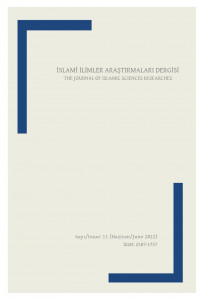Abstract
Arabic grammar has an important position within the framework of religious sciences because it is instrumental in understanding Islamic sciences correctly. Because, as the rules are internalized and comprehended in this science, tafsir, jurisprudence, kalam, etc., espe-cially the Qur'an and hadiths. The dominance of the meaning in the sciences is also increa-sing. Therefore, it is not possible to reveal the messages in these religious texts clearly and completely without grammar. For this reason, Arabic grammar lessons, which were descri-bed as the science of tools, were given in educational institutions from the past to the pre-sent, and after the rules of the said science were obtained, the lessons of other Islamic sciences were given. Among the Arabic grammar sciences, the science of nahiv, which examines the i'rab status of words, has a separate privilege. because it is known which i'rab position the words in the sentence have on the occasion of nahiv science. This brings the meaning in an Arabic text to be revealed completely and completely. It is not possible to know according to which meaning the meaning will be expressed without understanding whether a member word in a parable sentence is a mef'ul or a state. Nahiv is generally divi-ded into three parts as merfûat, mensûbat and mecrûrat. In all three parts, there are ele-ments that need studies such as analysis and comparison, which can be handled individu-ally due to the different situations of some elements and their relations with each other. Therefore, in this study, we tried to make a comparison between the mef’ûlu bih element, which constitutes the original part of the members part, and the state element, which is closely related to this element, after analyzing them one by one, by revealing the similarities and differences between them.
Keywords
References
- Çârperdî, Ebü’l-Mekârim Fahrüddîn Ahmed b. el-Hasen b. Yûsuf Şerhu’l-Muğnî fi’n-Nahv, Midyat: Dâru Nuru’s-Sabâh, 2008.
- Fîrûzabâdî, Muhammed b. Yâkub. el-Kâmûsu’l-Muhît, Beyrut: Daru’l-Cil, trsz.
- Galâyînî, Mustafâ b. Muhammed Selîm b. Muhyiddîn b. Mustafâ Camiu’d-Durûsu’lʿArabiyye, Beyrut: Müessetu’r-Risâle, 2012.
- Kur’ân Yolu. Erişim 18 Ekim 2021.https://kuran.diyanet.gov.tr
- Hammûdî, Hadî Hasan Esâlîbu’t-Ta’bîr ‘İnde’l-Halil b. Ahmed, Beyrut: Dâru’l-Kütübi’l-İlmiyye, trsz.
- Hüsnî, Muhammed en-Nahvu’ş-Şâfî, Beyrut: Müessesetu’r-Risâle, 1997.
- İbn Manzûr, Muhameed b. Mukerrem b. Lisânu’l-‘Arab, Beyrut Daru İhyai’t-Turâsi’l-Arabî, 1990.
- İsferâyinî, İsâmuddin İbrahim b. Muhammed Şerhu’l-‘İsam alâ Kâfiyeti İbn-i Hâcib, Beyrut: Dâru’l-Kütübi’l-İlmiyye, trsz.
- Mervezî, Ebu’l-Feth olan Muhammed b. S‘ad b. Muhammed b. Muhammed b. Mu-hammed ed-Dîbâcî Hadâiku’d-Dekâik, İstanbul Salah Bilici Kitabevi, trsz.
- Molla Câmi, Nuruddin Abdurrahman el-Fevâidu’d-Diyâiyye, İstanbul: Haşimî Yayın-ları, 2017.
- Süyûtî, Ebü’l-Fazl Celâlüddîn Abdurrahmân b. Ebî Bekr b. Muhammed el-Hudayrî el-Eşbâh ve’n-Nezâir fi’Nahv, Beyrut: Dâru’l-Kütübi’l-İlmiyye, trsz.
- Şirâzî, Seyyid Sadık Tevz’ihâtün li’li’l-Behcet’l-Merziyye fi Şerh-i Elfiyye, Midyat: Dâru Nuru’s-Sabâh, 2008.
- Şirbînî, Şemsuddin Muhammed b. Ahmed el-Hatîb Muğisu’n-Nedâ Şerhu Katri’n-Nedâ, Beyrut: Dâru’l-Kütübi’l-İlmiyye, trsz.
Abstract
Arapça gramer ilmi, İslamî ilimlerin doğru anlaşılmasına vesile olması hasebiyle dinî ilimler çerçevesinde önemli bir konuma sahiptir. Zira bu ilimde kurallar içselleştirilip kavrandıkça başta Kur’an’ı Kerim ve Hadis-i Şerifler olmak üzere Tefsir, Fıkıh, Kelam vb. ilimlerdeki anla-ma olan hâkimiyet de artmaktadır. Dolayısıyla gramer ilmi olmadan bu dinî metinlerdeki mesajları açık ve tam bir şekilde ortaya koymak mümkün değildir. Bunun için eskiden günü-müze kadar eğitim kurumlarında önce araç ilmi olarak nitelendirilen Arap gramer ilmi ders-leri verilip söz konusu ilmin kurallarına vükûfiyet sağlandıktan sonra amaç olan diğer İslamî ilimlerin dersleri verilmiştir. Arapça gramer ilimleri arasında kelimelerin i’rab durumlarını inceleyen Nahiv ilminin ayrı imtiyazı vardır. Zira Nahiv ilmi vesilesiyle cümle içerisinde geçen kelimelerin hangi i’rab konumuna sahip olduğu bilinmektedir. Bu da Arapça bir metindeki anlamın tam ve eksiksiz olarak ortaya konmasını beraberinde getirir. Mesela bir cümlede geçen mansûp bir kelimenin mef’ul veya hâl olduğu anlaşılmadan anlamın hangisine göre ifade edileceği bilinemez. Nahiv, genel olarak merfûât, mansûbât ve mecrûrât olarak üç kısma ayrılmaktadır. Her üç kısımda da farklı durumları ve birbirine olan münasebetleri hasebiyle tek olarak ele alınıp tahlil ve mükâyese gibi çalışmalara ihtiyaç duyan öğeler vardır. Dolayısıyla bu çalışmada mensûbât kısmının aslını teşkil eden mef’ûlü bih öğesi ile bu öğeye yakın müna-sebet içinde olan hâl öğesini önce tek tek ele alınıp tahlil edildikten sonra aralarındaki ben-zerlik ve farklılıkları ortaya koymak sûretiyle bir mükâyese yapılmaya çalışıldı.
Keywords
References
- Çârperdî, Ebü’l-Mekârim Fahrüddîn Ahmed b. el-Hasen b. Yûsuf Şerhu’l-Muğnî fi’n-Nahv, Midyat: Dâru Nuru’s-Sabâh, 2008.
- Fîrûzabâdî, Muhammed b. Yâkub. el-Kâmûsu’l-Muhît, Beyrut: Daru’l-Cil, trsz.
- Galâyînî, Mustafâ b. Muhammed Selîm b. Muhyiddîn b. Mustafâ Camiu’d-Durûsu’lʿArabiyye, Beyrut: Müessetu’r-Risâle, 2012.
- Kur’ân Yolu. Erişim 18 Ekim 2021.https://kuran.diyanet.gov.tr
- Hammûdî, Hadî Hasan Esâlîbu’t-Ta’bîr ‘İnde’l-Halil b. Ahmed, Beyrut: Dâru’l-Kütübi’l-İlmiyye, trsz.
- Hüsnî, Muhammed en-Nahvu’ş-Şâfî, Beyrut: Müessesetu’r-Risâle, 1997.
- İbn Manzûr, Muhameed b. Mukerrem b. Lisânu’l-‘Arab, Beyrut Daru İhyai’t-Turâsi’l-Arabî, 1990.
- İsferâyinî, İsâmuddin İbrahim b. Muhammed Şerhu’l-‘İsam alâ Kâfiyeti İbn-i Hâcib, Beyrut: Dâru’l-Kütübi’l-İlmiyye, trsz.
- Mervezî, Ebu’l-Feth olan Muhammed b. S‘ad b. Muhammed b. Muhammed b. Mu-hammed ed-Dîbâcî Hadâiku’d-Dekâik, İstanbul Salah Bilici Kitabevi, trsz.
- Molla Câmi, Nuruddin Abdurrahman el-Fevâidu’d-Diyâiyye, İstanbul: Haşimî Yayın-ları, 2017.
- Süyûtî, Ebü’l-Fazl Celâlüddîn Abdurrahmân b. Ebî Bekr b. Muhammed el-Hudayrî el-Eşbâh ve’n-Nezâir fi’Nahv, Beyrut: Dâru’l-Kütübi’l-İlmiyye, trsz.
- Şirâzî, Seyyid Sadık Tevz’ihâtün li’li’l-Behcet’l-Merziyye fi Şerh-i Elfiyye, Midyat: Dâru Nuru’s-Sabâh, 2008.
- Şirbînî, Şemsuddin Muhammed b. Ahmed el-Hatîb Muğisu’n-Nedâ Şerhu Katri’n-Nedâ, Beyrut: Dâru’l-Kütübi’l-İlmiyye, trsz.
Details
| Primary Language | Turkish |
|---|---|
| Subjects | Religious Studies, Religion, Society and Culture Studies |
| Journal Section | Research Articles |
| Authors | |
| Publication Date | June 15, 2022 |
| Submission Date | March 30, 2022 |
| Published in Issue | Year 2022 Issue: 11 |


